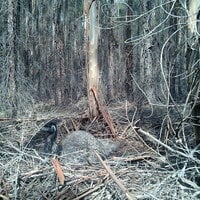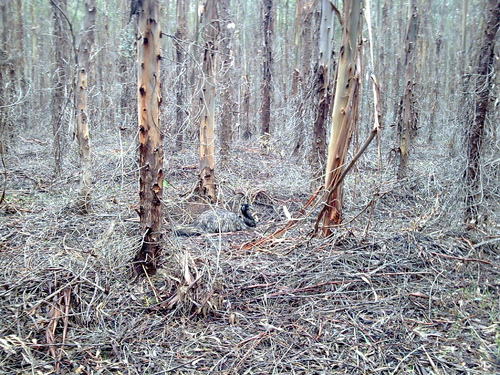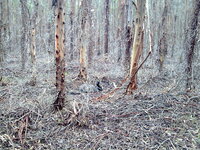- Nov 9, 2013
- 1,368
- 1,459
- 291
Got two breeding-pairs in ‘orbit’ here at present:
I’m watching this with interest. Tooshtoosh and Mrs. T. failed to mate – not a biggie for such a young male – and remained a pair, and stayed here. Okay.
And a little later, Limpychick returned after having left last winter. She brought Mr. Limpychick. We have no idea if she mated.
Now, somewhere in the long ago, I posted about ‘overlapping major and minor pastures.’ That is, T. and Mrs. T. usually come for breakfast, then choof off. Sometimes they come in the evening. Sometimes not. So we are certain enough that they graze on the half dozen pastures within a mile or two of here. (Plentiful water.)
And Limpychick and Mr. are also definitely in orbit. But they only touch down here once a fortnight or so.
And there are also random wild birds, male and female, coming and going. And we are sure enough that these wild birds know this pasture – the house-clearing with all its attendant goodies – from past visits.
I wish we could track a pair. Don’t want to capture birds, or tracking devices, blah blah blah. But even just as a thought experiment:
I would dearly like to know the ‘ambit’ of their travels. We have piles of observations of emus in one place or another. We can sometimes make clumsy guesses about their travels from the presence of water. Or how long they are absent (two and a half years . . . )
[Years ago, I was about a mile from the farmhouse, sitting quietly in the bush. A pair of emus appeared, and one just walked quietly up to me. It was Eric, whom I had not seen for quite some time (and Mrs Eric with him). And I worked out over years that Felicity used to cross the highway, and go south. She'd 'operate' from that territory for months while still regularly visiting the house-clearing. At times, I've seen here from five hundred yards away, plodding down the track from the highway, sometimes with a prospective consort in tow.]
If you take this to the next level, you get an insight into How Much Room Does An Emu Need?
The woodwardi emus – the desert top-half of West Oz – surely travel hundreds and hundreds of miles over time. Likewise the novaehollandiae of the east, who roam outback Queensland. I’ve hitched across this part of Oz. It’s huge.
[To put this in perspective. Folks from the States prolly think of Texas as the wide open spaces – actually, yeh, it is. But Texas has over 100 people per square mile. Western Australia has 2.5]
What if we could know, at one time, the ‘major and minor pastures’ of, say, T. and Mrs. T., and Limpychick and consort, and one local rothschildi female who has passed by my garden this spring, and one woodwardi, and one novaehollandiae; and watch these birds in their travels.
I’m watching this with interest. Tooshtoosh and Mrs. T. failed to mate – not a biggie for such a young male – and remained a pair, and stayed here. Okay.
And a little later, Limpychick returned after having left last winter. She brought Mr. Limpychick. We have no idea if she mated.
Now, somewhere in the long ago, I posted about ‘overlapping major and minor pastures.’ That is, T. and Mrs. T. usually come for breakfast, then choof off. Sometimes they come in the evening. Sometimes not. So we are certain enough that they graze on the half dozen pastures within a mile or two of here. (Plentiful water.)
And Limpychick and Mr. are also definitely in orbit. But they only touch down here once a fortnight or so.
And there are also random wild birds, male and female, coming and going. And we are sure enough that these wild birds know this pasture – the house-clearing with all its attendant goodies – from past visits.
I wish we could track a pair. Don’t want to capture birds, or tracking devices, blah blah blah. But even just as a thought experiment:
I would dearly like to know the ‘ambit’ of their travels. We have piles of observations of emus in one place or another. We can sometimes make clumsy guesses about their travels from the presence of water. Or how long they are absent (two and a half years . . . )
[Years ago, I was about a mile from the farmhouse, sitting quietly in the bush. A pair of emus appeared, and one just walked quietly up to me. It was Eric, whom I had not seen for quite some time (and Mrs Eric with him). And I worked out over years that Felicity used to cross the highway, and go south. She'd 'operate' from that territory for months while still regularly visiting the house-clearing. At times, I've seen here from five hundred yards away, plodding down the track from the highway, sometimes with a prospective consort in tow.]
If you take this to the next level, you get an insight into How Much Room Does An Emu Need?
The woodwardi emus – the desert top-half of West Oz – surely travel hundreds and hundreds of miles over time. Likewise the novaehollandiae of the east, who roam outback Queensland. I’ve hitched across this part of Oz. It’s huge.
[To put this in perspective. Folks from the States prolly think of Texas as the wide open spaces – actually, yeh, it is. But Texas has over 100 people per square mile. Western Australia has 2.5]
What if we could know, at one time, the ‘major and minor pastures’ of, say, T. and Mrs. T., and Limpychick and consort, and one local rothschildi female who has passed by my garden this spring, and one woodwardi, and one novaehollandiae; and watch these birds in their travels.




